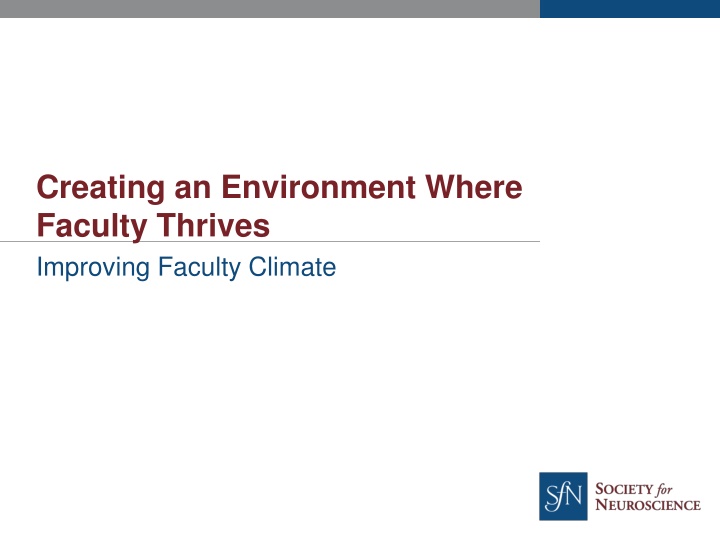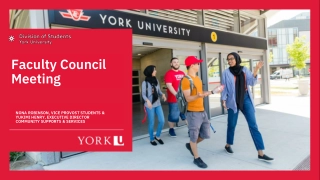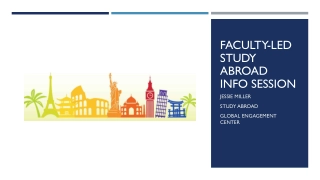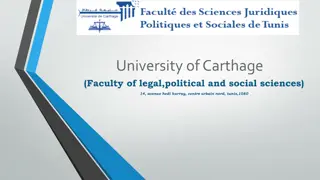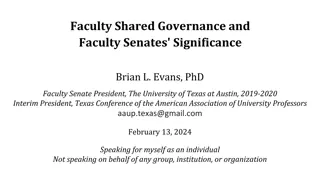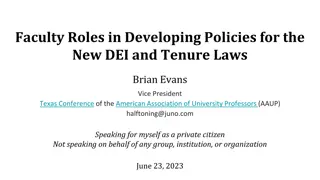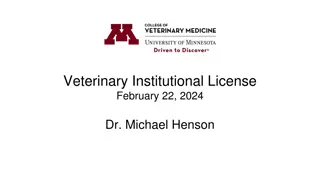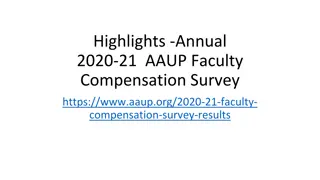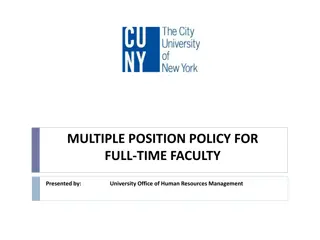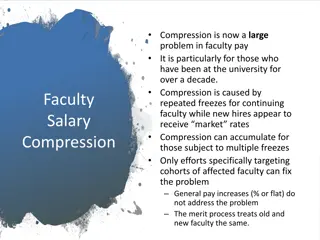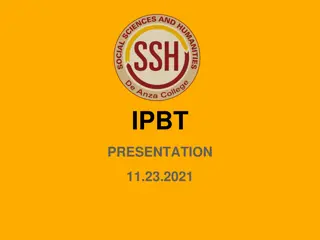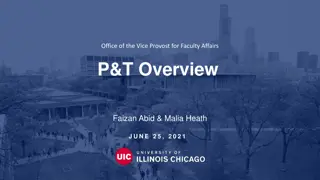Creating an Environment Where Faculty Thrives
In considering faculty climate issues based on gender perceptions from universities like UW-Madison, Harvard, CWRU, and VT, the importance of creating a safe, inclusive space where all members feel valued and respected is highlighted. Understanding the benefits of diverse perspectives and fair treatment in academic environments is crucial for fostering success.
Download Presentation

Please find below an Image/Link to download the presentation.
The content on the website is provided AS IS for your information and personal use only. It may not be sold, licensed, or shared on other websites without obtaining consent from the author.If you encounter any issues during the download, it is possible that the publisher has removed the file from their server.
You are allowed to download the files provided on this website for personal or commercial use, subject to the condition that they are used lawfully. All files are the property of their respective owners.
The content on the website is provided AS IS for your information and personal use only. It may not be sold, licensed, or shared on other websites without obtaining consent from the author.
E N D
Presentation Transcript
Creating an Environment Where Faculty Thrives Improving Faculty Climate
Is There a Problem? Data from four universities suggests that it depends on who you ask.
Climate Issues: Perceptions Differ by Gender (UW-Madison) The climate for women in my department is good % Agree Strongly or Somewhat 100.0% * 80.0% * 60.0% 40.0% 20.0% 0.0% Men Faculty Women Faculty Dept. Chairs
Climate Issues: Perceptions Differ by Gender (Harvard)
Climate Issues: Perceptions Differ by Gender (CWRU) Diana Bilimoria, IWiN (2010) CWRU 2004 Climate Survey
Climate Issues: Perceptions Differ by Gender (VT) *Campus free of intimidation, harassment, discrimination *Campus free f intimidation, harassment, discrimination *Read/heard/seen offensive comments/materials in workplace *Read/heard/seen offensive comments/materials in workplace *Faculty treated fairly regardless of gender *Faculty treated fairly regardless of sexual orientation *Faculty treated fairly regardless of gender *Faculty treated fairly regardless of *There is accountability for sexist behavior sexual orientation *Dept. head unlikely to intervene if sexist behavior occurred *There is accountability for sexist behavior *Dept. head unlikely to intervene if sexist behavior occurred Males Advance Survey, N=816; Includes combined responses of strongly agree and somewhat agree; *Items significantly different by gender, p < .05 Females 0% 20% 40% 60% 80% 100% Virginia Tech 2005 AdvanceVT Faculty Work-Life Survey and Faculty Exit Survey Diana Bilimoria, IWiN 9-23-2010
Why is Climate Important? What would be the benefits of creating a departmental climate where members feel safe, listened to, valued, and treated fairly and with respect ?
Why is Climate Important? The Power of Diversity Breakthroughs emerge by looking at complex problems from diverse perspectives. Inclusive enterprises with a diverse work force that recognize and value unique individual contributions tend to be more successful than more homogenous ones Scott Page, The Difference: How the Power of Diversity Creates Betters Groups, Firms, Schools, and Societies (2008)
How does diversity make us stronger? It seems obvious that groups of people with diverse individual expertise would be better than a homogeneous group at solving complex, non-routine problems It is less obvious that social diversity should work in the same way yet the science shows that it does. Being around people who are different from us makes us more creative, more diligent and harder-working Katherine W. Philips, Scientific American, October 1, 2014
Why Focus on Improving Departmental Climate? Improve departmental stability Increase faculty & student productivity Recruit and retain faculty and students Promote respect, collegiality, inclusion, collaboration, and cooperation in department Improve the science Chisholm-Burns, Richardson & Rodrigues, University of Arizona ADVANCE Program
Why Focus on Department Chairs? Individuals experience climate in their immediate workplace the department Chairs can significantly influence women s experiences in their departments Chairs perspectives of climate differ from those of other faculty, especially women faculty Study of Faculty Worklife at the University of Wisconsin-Madison, 2003
The Impact of Committed Leaders Leaders have a disproportionate impact on organizations because of their status as authorities 1. Establish and publicize policies to increase fairness 2. Legitimize and support the leadership of both women & men Why So Slow? The Advancement of Women. Virginia Valian, MIT Press, 1997
Impact of Leaders: Two Examples John Stobo, MD Chairman of Medicine, Johns Hopkins Medical School (1958-1997) Lawrence Summers, PhD 27th President of Harvard University (2001-2006) Resigned following no-confidence vote by faculty Suggested that female faculty different availability of aptitude at the high end However, also initiated changes that increased female and minority faculty
Impact of Leaders John Stobo, MD, Chairman of Medicine, Johns Hopkins Medical School, 1985-1997 Women faculty earned less than men and advanced more slowly. Appointed a committee to evaluate situation and develop ways to deal with gender-based problems. Stobo s initiatives included: Annual faculty evaluations with explicit info re progress. Monthly meetings with concrete mentoring for moving up in career. Senior faculty were given explicit info on how to mentor. Important meetings moved from outside normal hrs. Impact on the Dept. of Medicine 1990 there were 6 women Assoc. Profs. 1995 there were 26 women Assoc. Profs. Career Development for women in academic medicine: Multiple interventions in a department of medicine. Fried et al JAMA 1996; 276:898
Impact of Leaders Lawrence Summers, PhD, President, Harvard 2001-2006 Summers appointed two task forces (2005) The task forces recommendations included: Senior Vice Provost for Faculty Development & Diversity Increased recruitment efforts Implemented improved mentoring and advising Instituted retention strategies (new tenure track for jr. faculty) Established official parental leave and automatic extension of tenure clock Grants of up to $20,000/yr. to 50+ faculty member for childcare Dependent care fund for children to travel with parents to conferences New babysitting service Professional Permutations: Harvard s Evolving Faculties by Jonathan Shaw Harvard Magazine September-October 2011
Impact of Changes at Harvard More Women & Minority Appointments Professional Permutations: Harvard s Evolving Faculties by Jonathan Shaw Harvard Magazine September-October 2011
Essential Climate Components For the advancement of women and minorities (and the benefit of all faculty), a department s policy should aim for Transparency: Making all kinds of information available and easy to find Uniformity: Leveling the field and dealing equitably with all faculty Assistance: Attending to the needs of faculty; offering mentoring and other types of help Best Practices University of Michigan ADVANCE Program
Strategies to Improve Retention and Climate Invite diverse scientists as speakers in departmental seminars Delay tenure clock for birth of a child, caring for sick family member (must apply to all faculty) Implement mentoring programs Implement dual career hiring/retention programs
How a Chair Can Change the Climate Motivate change within department: develop compelling rationales for change, focusing on benefits to department Use diversity as window on departmental effectiveness; everyone benefits: continuous thread linking students, postdocs, women and men faculty Attract more women and URMs as faculty Improve morale Accountability: Principles and actions for chairs and unit heads, Virginia Valian, Hunter College
How a Chair Can Change the Climate (cont.) Develop faculty for leadership positions within institution Establish paths toward leadership Place women and minorities on important committees Provide guidelines on how to run committees Have periodic meetings with interested faculty to explain how decisions are made within institution Accountability: Principles and actions for chairs and unit heads, Virginia Valian, Hunter College
How a Chair Can Change the Climate (cont.) Develop a diverse circle of advisors Determine what you need and who can fulfill those needs Include people who will provide constructive criticism and objections Chairs are at risk of isolation from and lack of knowledge of hidden problems everyone tends to assume their unit is working well unless there are major overt signs to the contrary Accountability: Principles and actions for chairs and unit heads, Virginia Valian, Hunter College
How a Chair Can Change the Climate (cont.) Develop procedures to counteract unintended bias Review colloquium speaker roster reflect % women grad students & in field Run faculty meetings so that everyone s voice is attended to Review letters of recommendation for gender equity Review workload assignments (teaching and service) for equity Importance of assignment Labor-intensiveness of assignment Visibility Scope for innovation Ensure that departmental-internal staff respond equally promptly and fully to males and females, non-minority and minority Ensure that women and minorities have a voice in hiring Accountability: Principles and actions for chairs and unit heads, Virginia Valian, Hunter College, GEP http://www.hunter.cuny.edu/genderequity/equitymaterials.html
How a Chair Can Change the Climate (cont.) Examples for the University of Minnesota Scott Lanyon Dept. of Ecology, Evolution, and Behavior To improve climate, adjusted the time of the Dept. Seminar and added a reception to build community Moved the seminar earlier in the afternoon to encourage seminar and reception participation by faculty members with young children Added a post-seminar reception (with food and drink [including beer and wine]) to which faculty, graduate students, and postdocs are invited To improve climate, initiated a Celebration of Promotions
A Closing Thought Never doubt that a small group of thoughtful, committed citizens can change the world; Indeed, it s the only thing that ever has. Margaret Meade
Caveats Institutional Transformation takes TIME Constraints on ability to undergo transformation Culture of institution Hierarchical? Driven by strong faculty governance system? Size of institution Availability of resources time, personnel, funds Support of top administrators Turnover of administrators and chairs
